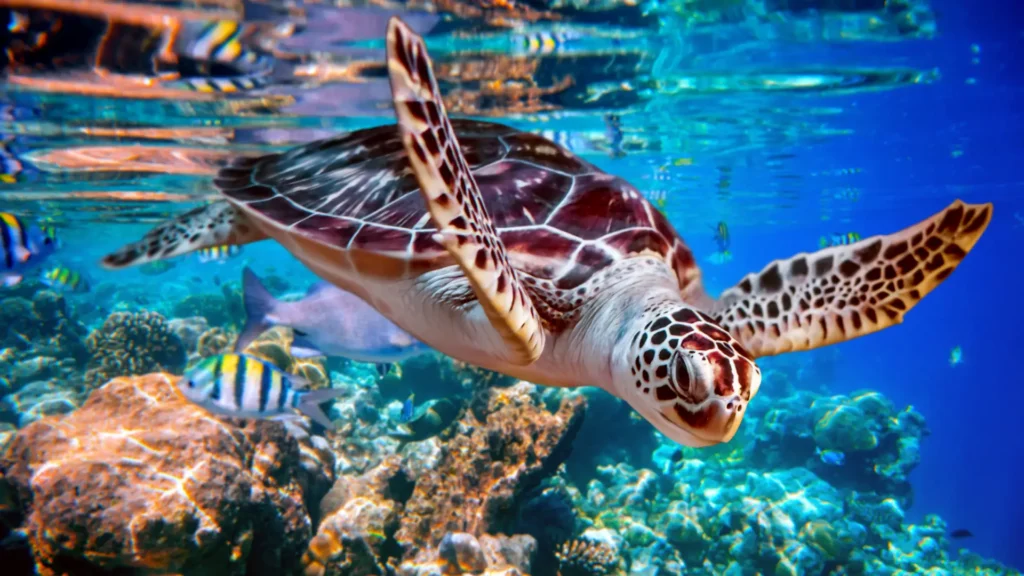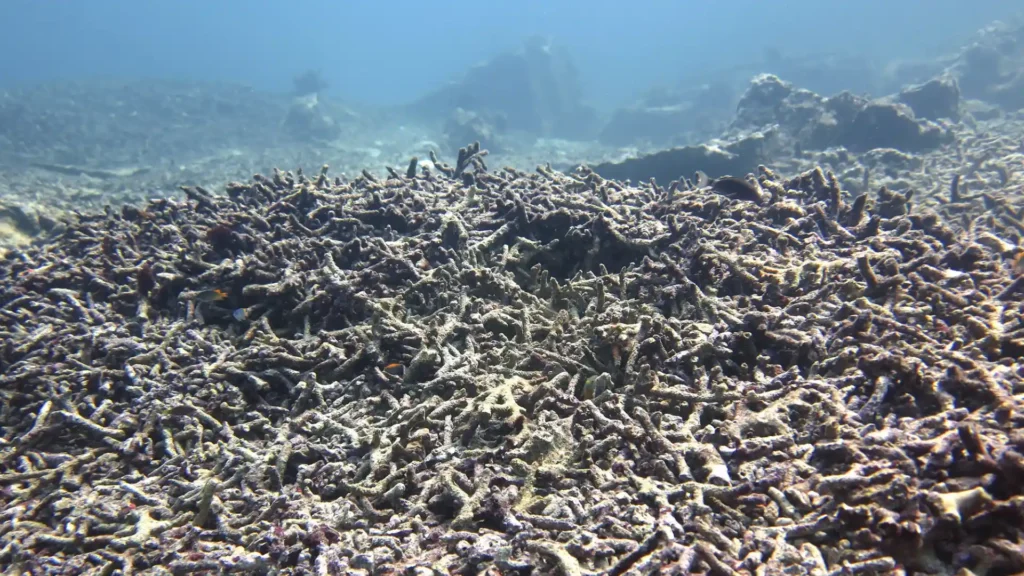Introduction
When an animal species becomes extinct, it means there are no more of them left on the planet. Sadly, we are now living through the world’s sixth mass extinction and the United Nations says that one million species are at risk of becoming extinct.1https://www.un.org/sustainabledevelopment/blog/2019/05/naturedecline-unprecedented-report/ We are losing species 1,000 times faster than is natural.2Pimm SL, Jenkins CN, Abell R et al. 2014. The biodiversity of species and their rates of extinction, distribution, and protection. Science. 344 (6187) 1246752. Unlike previous extinction events that were caused by asteroids, volcanic eruptions and natural climate shifts, this emergency is caused by humans – with animal farming at the heart of it.
What is biodiversity and how many species are there on Earth?
Biodiversity means all the amazing variety of life on Earth – from tiny microorganisms to gigantic animals and towering trees. We don’t know exactly how many different species live on the planet, but it’s around nine million, and only 14 per cent on land and nine per cent in the oceans have been named by scientists.3https://www.science.org/content/article/meat-eaters-may-speed-worldwide-speciesextinction-study-warns We face losing many more species before they have even been discovered.
Find out more
The International Union for Conservation of Nature’s (IUCN) Red List of Threatened Species gives us clues about the health of the world’s biodiversity. To date, more than 147,500 species have been looked at by the IUCN and more than 41,000 (28 per cent) of them are threatened with extinction.4https://www.iucnredlist.org The diagram below shows the percentages of certain species under threat, including 27 per cent of mammals and 13 per cent of birds.

Aggressive animal farming

Turning forests and grasslands into animal farms is the single biggest cause of wildlife loss.5Jaureguiberry P, Titeux N, Wiemers M et al. 2022. The direct drivers of recent global anthropogenic biodiversity loss. Science Advances. 8 (45) eabm9982 When natural ecosystems are destroyed to make room for farming, the wildlife that live there lose their homes and are killed. Over the last 50 years, turning natural land into crop and animal farms has been the main cause of habitat destruction and biodiversity loss.6https://www.chathamhouse.org/2021/02/food-system-impacts-biodiversity-loss The expansion of farming threatens 62 per cent of endangered species.7Maxwell SL, Fuller RA, Brooks TM et al. 2016. Biodiversity: The ravages of guns, nets and bulldozers. Nature. 536 (7615) 143-145
Humans cannot survive without rich biodiversity. The air we breathe, water we drink, food we eat and medicines we depend on, all rely heavily on biodiversity. The professor of wildlife conservation at the University of Oxford says: “Without biodiversity, there is no future for humanity.”8https://www.theguardian.com/news/2018/mar/12/what-is-biodiversity-and-why-does-it-matter-to-us
A world out of balance

The imbalance of life on Earth is scary. Humans and wildlife are hugely outnumbered by farmed animals. By weight, 60 per cent of mammals on the planet are farmed animals, 36 per cent are humans and just four per cent are wild animals.9Bar-On YM, Phillips R and Milo R. 2018. The biomass distribution on Earth. Proceedings of the National Academy of Sciences. 115 (25) 6506-6511 There are over 24 billion chickens in the world – more than three birds for every one person. Since 1970, the number of people and livestock has risen massively, but the number of wild mammals has fallen by a shocking 82 per cent.6https://www.chathamhouse.org/2021/02/food-system-impacts-biodiversity-loss The more animals we farm, the more wildlife we lose.
Find out more
Whichever way you look at it, farmed animals massively outnumber the world’s natural wildlife, and animal farming is destroying the planet. So many farmed animals cause huge problems for biodiversity, including their contribution to climate change, deforestation, change of land use, overgrazing, degradation of grasslands and desertification. Huge areas of cropland are used to produce food for farmed animals, such as soya, maize and palm oil, so meat-eaters are directly contributing to this destruction.
“All in all, our food system is the major factor underpinning reductions in the population sizes of wild species of animals and plants, and the erosion of biodiversity, from the local level to the global level.”6https://www.chathamhouse.org/2021/02/food-system-impacts-biodiversity-loss
From insects to elephants

Over 40 per cent of the world’s insects are in danger, having lost their homes to intensive farming.10Sánchez-Bayo F and Wyckhuys KAG. 2019. Worldwide decline of the entomofauna: A review of its drivers. Biological Conservation. 232, 8-27 Experts say intensive farming and the increased use of pesticides (chemicals used to kill insects) over the last 50 years have caused the massive declines. It’s an insect apocalypse! 87% of all plant species need animal pollination and most of this is done by insects. Around three-quarters of all crop types grown by people need to be pollinated by insects. If we want to survive – -we need insects! Insects are vital for many ecosystems and without them, the entire web of life would collapse and all life on Earth could be at risk
Around 60 per cent of primates are at risk of extinction because of habitat loss, farming, deforestation, cattle ranching, hunting for bushmeat, illegal trade as pets or ‘medicinal’ body parts, and climate change. The homes of primates are being destroyed to farm soya, palm oil and beef.11Estrada A, Garber PA and Chaudhary A. 2019. Expanding global commodities trade and consumption place the world’s primates at risk of extinction. PeerJ. 7:e7068
In both Africa and Asia, populations of great apes – gorillas, chimpanzees, bonobos and orangutans – are rapidly falling. There are less than 1,100 mountain gorillas left in the mountains of the Democratic Republic of Congo, Rwanda and Uganda – the last haven of mountain gorillas in the world.12https://www.unep.org/news-and-stories/story/covid-19-climate-change-threaten-lastrefuge-mountain-gorilla The western chimpanzee in Africa and all three species of orangutans in Asia are now listed as critically endangered.4https://www.iucnredlist.org
Years of habitat loss, poaching and war have almost wiped out African elephants too, with only around 350,000 remaining compared to the 10 million that roamed Africa in 1930.13Chase MJ, Schlossberg S, Griffin CR et al. 2016. Continent-wide survey reveals massive decline in African savannah elephants. PeerJ. 4, e2354 Grasslands are also being destroyed for beef farming and the Ugandan savannah is a prime example of this. Roaming elephants and buffalo, leopards and lions, grasshoppers and beetles, ants and termites make up an incredible ecosystem that has evolved over thousands of years, but which is now under threat from animal farming.
“You eat a steak, you kill a lemur in Madagascar. You eat a chicken, you kill an Amazonian parrot.”3https://www.science.org/content/article/meat-eaters-may-speed-worldwide-speciesextinction-study-warns Each bite fuels mass species extinction and drives global deforestation. When choosing meat, you are eating the Earth. Choose vegan instead.
Underwater and under threat

In the seas and oceans, fishing is the largest cause of biodiversity loss. In rivers and lakes (and oceans too), wildlife is affected by farm chemicals, such as fertilisers and pesticides, getting into the water.
In the oceans, too many fish are being caught. Over a third of wild fish are now overfished, compared to 10 per cent in 1974.14https://doi.org/10.4060/ca9229en Larger fish are being killed by fishermen or starving because there aren’t as many small fish for them to eat. Without big changes, more than half of the world’s ocean animals may face extinction in the next 80 years.15http://www.unesco.org/new/en/natural-sciences/ioc-oceans/focus-areas/rio-20-ocean/blueprint-for-the-future-we-want/marine-biodiversity/facts-and-figures-on-marinebiodiversity/
Coral reefs support more than a quarter of all ocean life but around half of all shallow water corals have already been lost due to overfishing and rising sea temperatures. In addition, as carbon dioxide from the atmosphere dissolves in the ocean, it makes the sea more acidic, damaging and killing the coral. Up to 90 per cent could be gone by 2050.16wwf.panda.org/knowledge_hub/all_publications/living_planet_report_2018/
We often only think of trees as giving us oxygen but half of the Earth’s oxygen comes from tiny microalgae (phytoplankton) in the sea. Like plants and trees above ground, they also store carbon dioxide to keep the planet healthy. But their numbers are falling by one per cent every year17Boyce DG, Lewis MR and Worm B. 2010. Global phytoplankton decline over the past century. Nature. 466 (7306) 591-596 18Gregg WW, Rousseaux CS and Franz BA. 2017. Global trends in ocean phytoplankton: a new assessment using revised ocean colour data. Remote Sensing Letters. 8 (12) 1102-1111, adding yet another assault on the ocean and a blow to the future of humanity.

Scientists say we should reduce the animal foods we eat and replace them with more sustainable plant foods. A future with a lower demand for meat, fish, eggs and dairy would drastically reduce habitat and biodiversity loss, fossil fuel energy use, greenhouse gas emissions and pollution. In addition, a healthy plant-based diet would greatly improve global health.19Machovina B, Feeley KJ and Ripple WJ. 2015. Biodiversity conservation: The key is reducing meat consumption. Science of the Total Environment. 536, 419-431 We must make the connection between animal farming and environmental destruction, protect ecosystems and wild animals. If we don’t take action now, eating animals will be the death of us!
References
References
- 1
- 2Pimm SL, Jenkins CN, Abell R et al. 2014. The biodiversity of species and their rates of extinction, distribution, and protection. Science. 344 (6187) 1246752.
- 3
- 4
- 5Jaureguiberry P, Titeux N, Wiemers M et al. 2022. The direct drivers of recent global anthropogenic biodiversity loss. Science Advances. 8 (45) eabm9982
- 6
- 7Maxwell SL, Fuller RA, Brooks TM et al. 2016. Biodiversity: The ravages of guns, nets and bulldozers. Nature. 536 (7615) 143-145
- 8
- 9Bar-On YM, Phillips R and Milo R. 2018. The biomass distribution on Earth. Proceedings of the National Academy of Sciences. 115 (25) 6506-6511
- 10Sánchez-Bayo F and Wyckhuys KAG. 2019. Worldwide decline of the entomofauna: A review of its drivers. Biological Conservation. 232, 8-27
- 11Estrada A, Garber PA and Chaudhary A. 2019. Expanding global commodities trade and consumption place the world’s primates at risk of extinction. PeerJ. 7:e7068
- 12
- 13Chase MJ, Schlossberg S, Griffin CR et al. 2016. Continent-wide survey reveals massive decline in African savannah elephants. PeerJ. 4, e2354
- 14
- 15
- 16
- 17Boyce DG, Lewis MR and Worm B. 2010. Global phytoplankton decline over the past century. Nature. 466 (7306) 591-596
- 18Gregg WW, Rousseaux CS and Franz BA. 2017. Global trends in ocean phytoplankton: a new assessment using revised ocean colour data. Remote Sensing Letters. 8 (12) 1102-1111
- 19Machovina B, Feeley KJ and Ripple WJ. 2015. Biodiversity conservation: The key is reducing meat consumption. Science of the Total Environment. 536, 419-431

